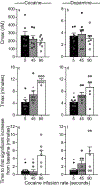Varying the rate of intravenous cocaine infusion influences the temporal dynamics of both drug and dopamine concentrations in the striatum
- PMID: 29757478
- PMCID: PMC6296906
- DOI: 10.1111/ejn.13941
Varying the rate of intravenous cocaine infusion influences the temporal dynamics of both drug and dopamine concentrations in the striatum
Abstract
The faster drugs of abuse reach the brain, the greater is the risk of addiction. Even small differences in the rate of drug delivery can influence outcome. Infusing cocaine intravenously over 5 vs. 90-100 s promotes sensitization to the psychomotor and incentive motivational effects of the drug and preferentially recruits mesocorticolimbic regions. It remains unclear whether these effects are due to differences in how fast and/or how much drug reaches the brain. Here, we predicted that varying the rate of intravenous cocaine infusion between 5 and 90 s produces different rates of rise of brain drug concentrations, while producing similar peak concentrations. Freely moving male Wistar rats received acute intravenous cocaine infusions (2.0 mg/kg/infusion) over 5, 45 and 90 s. We measured cocaine concentrations in the dorsal striatum using rapid-sampling microdialysis (1 sample/min) and high-performance liquid chromatography-tandem mass spectrometry. We also measured extracellular concentrations of dopamine and other neurochemicals. Regardless of infusion rate, acute cocaine did not change concentrations of non-dopaminergic neurochemicals. Infusion rate did not significantly influence peak concentrations of cocaine or dopamine, but concentrations increased faster following 5-s infusions. We also assessed psychomotor activity as a function of cocaine infusion rate. Infusion rate did not significantly influence total locomotion, but locomotion increased earlier following 5-s infusions. Thus, small differences in the rate of cocaine delivery influence both the rate of rise of drug and dopamine concentrations, and psychomotor activity. A faster rate of rise of drug and dopamine concentrations might be an important issue in making rapidly delivered cocaine more addictive.
Keywords: cocaine addiction; in vivo microdialysis; locomotor activity; male Wistar rats; pharmacokinetics.
© 2018 Federation of European Neuroscience Societies and John Wiley & Sons Ltd.
Conflict of interest statement
Conflict of Interest
The authors declare no conflicts of interest.
Figures






References
-
- Abreu ME, Bigelow GE, Fleisher L & Walsh SL (2001) Effect of intravenous injection speed on responses to cocaine and hydromorphone in humans. Psychopharmacology, 154, 76–84. - PubMed
-
- Allain F, Minogianis E-A, Roberts DC & Samaha A-N (2015) How fast and how often: The pharmacokinetics of drug use are decisive in addiction. Neuroscience & Biobehavioral Reviews, 56, 166–179. - PubMed
-
- Allain F, Roberts DC, Levesque D & Samaha AN (2017) Intermittent intake of rapid cocaine injections promotes robust psychomotor sensitization, increased incentive motivation for the drug and mGlu2/3 receptor dysregulation. Neuropharmacology, 117, 227–237. - PubMed
Publication types
MeSH terms
Substances
Grants and funding
- RGPIN-2016-06653/Sciences and Engineering Research Council (NSERC) of Canada/International
- 29651/Fonds de Recherche du Québec - Santé/International
- R01 EB003320/EB/NIBIB NIH HHS/United States
- T32 DA007268/DA/NIDA NIH HHS/United States
- 24326/Canada Foundation for Innovation/International
- 28988/Fonds de Recherche du Québec - Santé/International
- Fonds de Recherche du Québec - Nature et Technologies/International
- R37 EB003320/EB/NIBIB NIH HHS/United States
- Natural Sciences and Engineering Research Council of Canada/International
- BioFind and Dyskinesia Challenge - awarded to OSM/Michael J. Fox Foundation for Parkinson's Research/International
LinkOut - more resources
Full Text Sources
Other Literature Sources

